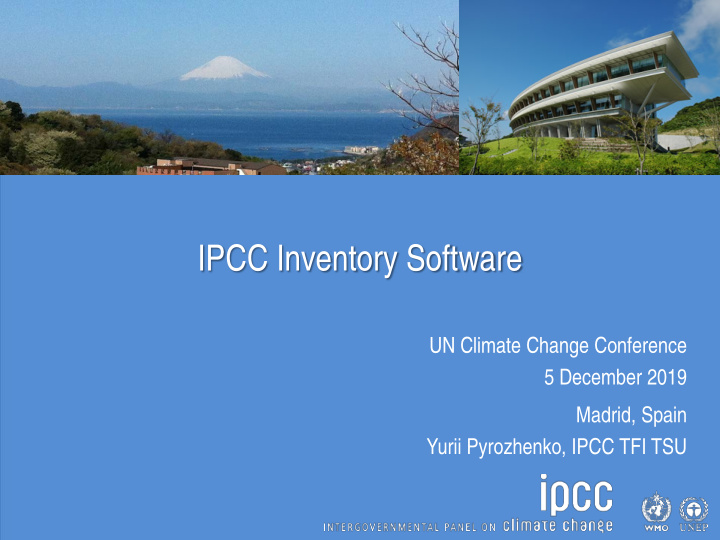



IPCC Inventory Software UN Climate Change Conference 5 December 2019 Madrid, Spain Yurii Pyrozhenko, IPCC TFI TSU
Outline Plans Software v.2.69: Livestock Software functions Background
Background IPCC Inventory Software is one of the tools produced by IPCC TFI to support development of National GHG Inventories by countries First Excel-based software was developed for Revised 1996 IPCC Guidelines Workbook, considering its wide usage by the countries at that time (some countries are still using this tool) In 2012 new MS-Access based IPCC Inventory Software was launched that implements the 2006 IPCC Guidelines Latest version 2.69 released in October 25, 2019 implements Tier 2 for most Energy, IPPU, Agriculture and Waste emission sources
Software functions (1) The software (42.5 MB exe file) can be quickly and freely downloaded from IPCC TFI web-site It is designed for MS Windows OS, for MacOS a windows emulator is needed The database is password protected and a hint to recover the password is to be provided (otherwise, once password is lost user can no longer access the database) Software allows to backup database as MDB file and export/import of worksheet data as XML file The Software (from v.2.0) can automatically convert the database to the latest version when older version is opened Please make sure to backup your database before upgrading the software to the new version! Non-English User Manual is available in addition to the official English version: French version translated by Government of Belgium Arabic version translated by Sidati Ould Dah Ould EIDA (CCPNCC)
Software Functions (2) Administration functions: Country, Users, QC, Uncertainty Years Contains default analysis, KCA, data Reference method Worksheets for data entry Data Managers : Data Export Land Types and and Livestock Import Data Archive
Software functions (3): Data flow between multiple users Project manager Sectoral Expert(s) Distribute updated DB (MDB Distribute empty database file) (MDB file) Compile Sector 1 PM: Initialise PM: Update Database Database Compile Sector 2 Combine Databases Combine Databases (XML File) (XML File) Compile Sector n Database Checks, Uncertainty, KCA Using XML file will reduce the chances of losing or overwriting the database unintentionally Prepare Outputs
Software functions (4): Reports Report Level Contents Summary 1.A.1 Emissions Short summary 1.A Emissions Sectoral 1.A.1.a.ii Emissions (most disaggregated level) Background 1.A.1.a.ii Activity data, (most disaggregated level) Emissions Note: All reports can be exported as MS Excel file
Software v.2.69: Livestock (1) Temperature Geographical zones Country/region Category Livestock Livestock manager Livestock Subcategory manager Subdivision Manure Management 17 MMS System
Software v.2.69: Livestock (2) Camels Goats Horses Mules and Sheep asses Buffalo Swine Livestock manager Other Poultry cattle Tier 1/Tier 2 Dairy Other cows Worksheets
Software v.2.69: Livestock (3) Why IPCC Inventory Software can be considered as user-friendly tool? Users can estimate emissions based on: Tier 1 and Tier 2 for all livestock categories simultaneously and compare results (QC) Detailed and Simplified method for cattle, buffalo and sheep simultaneously and compare results (QC) Either Tier 2 or direct input of country-specific data ( Calculated/Specified option ) Time series data entry option for multiple years without need to switch between inventory years
Software v.2.69: Livestock (4) Users do not need to enter data common for several categories several times, once such data inserted software will do their automatic transfer: From 3A1 to 3A2 and vice versa (e.g. Livestock population, Gross energy intake, Digestible energy etc.) From Tier 1 to Tier 2 and vice versa (Note: relevant only for livestock population) Nitrogen excretion rate data estimated in 3A2 are automatically transferred to relevant 3C categories Default IPCC values are provided in drop-down boxes both for Tier 1 and Tier 2 for all livestock categories for users’ convenience
Time series reporting Plans and multiple sectoral databases compilation* Completion of Tier 2 and alternative equations for a few non-AFOLU categories* 3B Tier 2 Uncertainty (+Wetlands and KCA: Supplement) Approach 2* 3B Approach 3: Land Representation* Possibility to produce all outcomes of estimates in XML format, which 3C Tier 2 then can be utilized by any new reporting framework / infrastructure * Subject to availability of resources
Thank you! https://www.ipcc-nggip.iges.or.jp/index.html
Recommend
More recommend